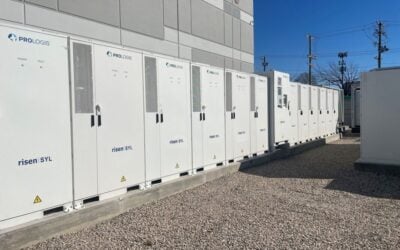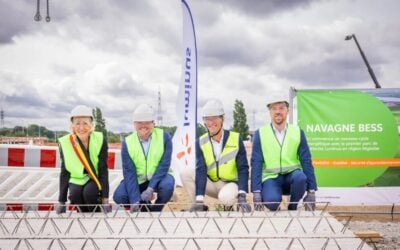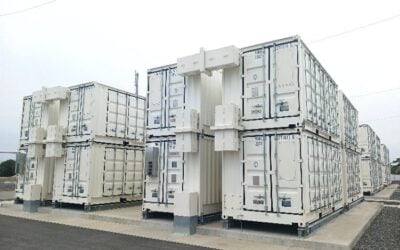Utilities have to catch on to the storage market. Credit: SolarWatt
The solar plus energy storage market is threatening the traditional utility business model, with a typical consumer able to reduce their reliance on electricity from the grid by 60-70%. As a result, utilities are trying to catch hold of the rising energy storage sector, which was evidenced by German utility E.On recently joining forces with German PV module and storage manufacturer Solarwatt. Energy Storage News caught up with Felix Brauer, training coordinator at SolarWatt, at the EcoBuild event in London to discuss the partnership in detail and the benefits of a DC-coupled battery system.
Why did E.On choose SolarWatt?
Enjoy 12 months of exclusive analysis
- Regular insight and analysis of the industry’s biggest developments
- In-depth interviews with the industry’s leading figures
- Annual digital subscription to the PV Tech Power journal
- Discounts on Solar Media’s portfolio of events, in-person and virtual
We have the best price and efficiency at present and our systems are perfect for retrofitting exisiting systems. We also have all the certificates for safety guidelines, which was an important factor for E.On. The utility also performed a couple of audits on our technology.
They want to sell the storage systems to private consumers and they have solar partners to install the systems. Our system suited their focus on the retrofitting market, because it is DC-coupled. This means it fits between the modules and the inverter and has the same electric characteristics as a module does. Therefore, we do not need any communication between the inverter and the storage system, which really makes it easy to install. There is no need for programming when the system is started – you just turn on the DC switch and its ready – that is one big advantage. E.On wanted it to be a fast install and we also have an award-winning design.
You can also use the existing inverter. Whereas for most of the other storage systems you need an island inverter for the storage systems or a specific inverter for the battery.
The DC coupling is also key, because I have not seen any AC coupled systems better than 80-85% efficency (normally they have 75-80% efficiency) and with our system we have a round trip charging and discharging efficiency of 93%, which is really outstanding.
How will the rollout take place?
We have already sent out the first pieces of the ‘MyReserve’ storage system. We have a contract for the next three years in which we have to deliver a large number of systems. The first market focus is in Germany because we are now certified in Germany, Austria and Switzerland.
E.On will have their own white cover and their own name for the MyReserve battery system, but we will continue to develop the system together and aim to have a system that fits us both perfectly and then we can expand our market.
What kind of market do you have?
This is for residential only and maybe later on for smaller commercial entities. We currently have this one system – the MyReserve 500 and the MyReserve 800. We have improved slightly so the MyReserve 500 can take 600 volts on the open circuit voltage and we are working on improving the MyReserve 800 to allow 850 volts.
We are starting with 4.4kWh batteries that can be expanded up to 11kWh and which can power a normal household through the night. However, for the typical German household, the basic version with 4.4kWh is just enough, because you want to have that system empty in the morning so it is really efficient without storing more than necessary.
The typical German household has a consumption of electricity from the gird of around 4,000kWh a year. Using a battery, solar PV and an energy management mechanism together, consumers can reduce that consumption to 1,500kWh (60-70%) through self-consumption, which is a 60-70% reduction in energy costs.
In Germany, the end customer price of the storage system is EUR5,500 (US$6,141) including tax, but without mounting. We never know where the system will be mounted and how long the wires will have to be, so the mounting costs are around EUR300-1,000. Installation is pretty fast, if all the wires are there, you just take 20 minutes to install the system with one person, which is a big advantage.
What are SolarWatt’s next steps?
For this year we are predicting sales of 5,000 pieces, which should grow to 20,000 in 2017, so we are really ramping up now. We are also looking at Australia, the Netherlands and France for expansion.
In Australia they have really high costs of energy and strong solar irradiation. Every market with high electricity prices and good irradiation is perfect for PV systems and storage.
We are starting to look at the UK market and the response has been huge. We are now in the certification process and we have our eyes open to see what we can do here with utilities as well.
Will we see more utilities taking on storage?
Almost all the utilities are trying to get in the market now, but they are a little bit late. they also started with renewables too late because in Germany we were installing 7GW a year between 2009-2012, but now we are at 1.5GW.
For us, it is good to have a contractwith E.On, but it is also good for the whole PV market, because they are going to have TV commercials promoting the benefits of solar.






